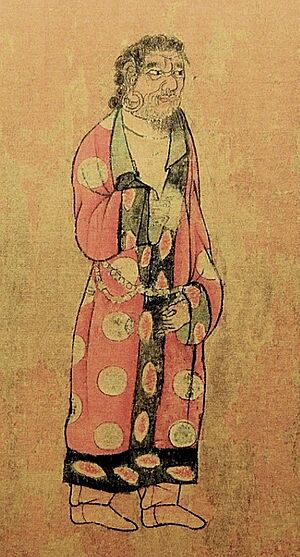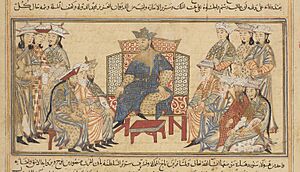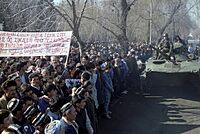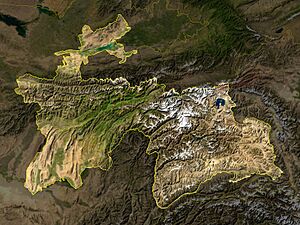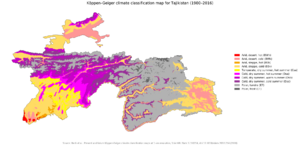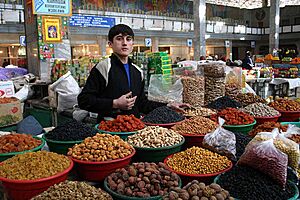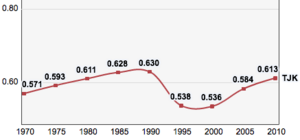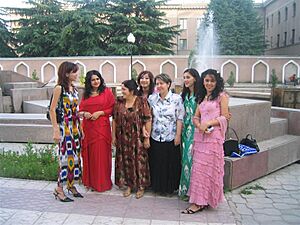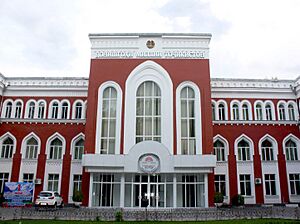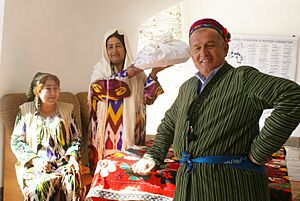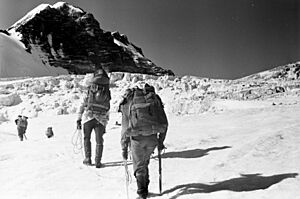Tajikistan facts for kids
Quick facts for kids
Republic of Tajikistan
Ҷумҳурии Тоҷикистон (Tajik)
|
|
|---|---|
|
|
|
|
Motto: Истиқлол, Озодӣ, Ватан (Tajik)
Istiqlol, Ozodí, Vatan "Independence, Freedom, Homeland" |
|
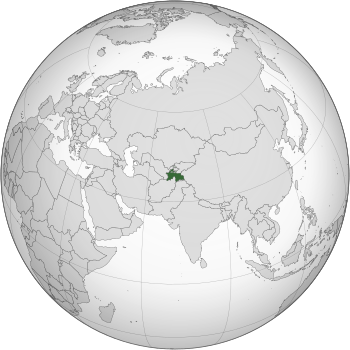
Location of Tajikistan (green)
|
|
| Capital and largest city
|
Dushanbe 38°33′N 68°48′E / 38.550°N 68.800°E |
| Official languages | Tajik (state) Russian (interethnic) |
| Ethnic groups
(2020)
|
|
| Religion
(2020)
|
97.5% Islam 0.7% Christianity 1.7% Irreligion 0.2% Others |
| Demonym(s) | Tajikistani • Tajiks |
| Government | Unitary presidential republic under an authoritarian dictatorship |
| Emomali Rahmon | |
| Kokhir Rasulzoda | |
| Legislature | Supreme Assembly |
| National Assembly | |
| Assembly of Representatives | |
| Formation | |
| 5 December 1929 | |
| 24 August 1990 | |
| 31 August 1991 | |
|
• Independence declared from USSR
|
9 September 1991 |
| 26 December 1991 | |
| Area | |
|
• Total
|
143,100 km2 (55,300 sq mi) (94th) |
|
• Water
|
2,575 km2 (994 sq mi) |
|
• Water (%)
|
1.8 |
| Population | |
|
• 2024 estimate
|
|
|
• Density
|
70.6/km2 (182.9/sq mi) (155th) |
| GDP (PPP) | 2024 estimate |
|
• Total
|
|
|
• Per capita
|
|
| GDP (nominal) | 2024 estimate |
|
• Total
|
|
|
• Per capita
|
|
| Gini (2015) | 34 medium |
| HDI (2022) | medium · 126th |
| Currency | Somoni (TJS) |
| Time zone | UTC+5 (TJT) |
| Date format | dd.mm.yyyy |
| Driving side | right |
| Calling code | +992 |
| ISO 3166 code | TJ |
| Internet TLD | .tj |
|
|
Tajikistan, officially the Republic of Tajikistan, is a country in Central Asia. It is a landlocked country, meaning it has no access to the sea. Dushanbe is its capital and largest city.
Tajikistan shares borders with Afghanistan to the south, Uzbekistan to the west, Kyrgyzstan to the north, and China to the east. A narrow strip of Afghanistan, called the Wakhan Corridor, separates it from Pakistan. About 10.6 million people live in Tajikistan.
This area has a very long history. Ancient cultures from the Neolithic and Bronze Age lived here, including the city of Sarazm. Later, many empires and groups ruled the land, bringing different faiths and cultures like Buddhism, Zoroastrianism, and Islam. Important empires included the Achaemenid Empire, Samanid Empire, and Mongol Empire.
In the 19th century, the Russian Empire took control of the region. Later, it became part of the Soviet Union. On December 5, 1929, it became the Tajik Soviet Socialist Republic within the Soviet Union.
Tajikistan declared its independence on September 9, 1991, as the Soviet Union was breaking apart. After independence, the country faced a civil war from 1992 to 1997. Since the war ended, the country has become more stable. Its economy has grown with help from other countries. Emomali Rahmon has led Tajikistan since 1994.
Tajikistan is a republic with four main regions. Most people are Tajiks, and their main language is Tajik. Russian is also used for communication between different ethnic groups. Most people (97.5%) follow Islam. Over 90% of the country is covered by mountains, especially the Pamir Mountains. Tajikistan is a developing country whose economy relies on money sent home by workers abroad, and on producing aluminium and cotton. It is a member of the United Nations and other international groups.
Contents
Exploring Tajikistan's Past
The history of this region goes back at least 6,000 years. Ancient cultures from the Bronze Age, like the Bactria–Margiana Archaeological Complex, lived here. The ancient site of Sarazm, a World Heritage Site, is also found here.
The first written records of the area are from around 500 BC. At that time, most of Tajikistan was part of the Achaemenid Empire. After Alexander the Great conquered the region, it became part of the Greco-Bactrian Kingdom.
Northern Tajikistan, including the cities of Khujand and Panjakent, was part of Sogdia. This area was taken over by nomadic tribes around 150 BC. The famous Silk Road passed through this region. This led to a lot of trade between the Han Empire of China and Sogdiana. Sogdians were important traders, farmers, and craftspeople.
The Kushan Empire controlled the region from the 1st to the 4th century AD. During this time, different religions like Buddhism, Nestorian Christianity, Zoroastrianism, and Manichaeism were practiced. Later, the Hephthalite Empire moved in, and in the 8th century, Arabs brought Islam.
The Samanid Empire: A Golden Age
The Samanid Empire ruled from 819 to 999. They brought back Persian control to the region. Cities like Samarkand and Bukhara grew into important cultural centers. The Samanid Empire was centered in Khorasan and Transoxiana. At its largest, it included Afghanistan, parts of Iran, Tajikistan, and other Central Asian countries.
Four brothers started the Samanid state. In 892, Ismail Samani united the state under one ruler. Under him, the Samanids became independent from the Abbasid rulers.
Later, the Kara-Khanid Khanate conquered Transoxania. Their arrival marked a shift from Iranian to Turkic influence in Central Asia. In the 13th century, the Mongol Empire invaded Central Asia, destroying cities and harming people. After them, Tamerlane founded the Timurid Empire.
Rule by Bukhara
What is now Tajikistan was ruled by the Khanate of Bukhara starting in the 16th century. When that empire fell in the 18th century, it came under the Emirate of Bukhara. This emirate lasted until the 20th century.
Russian Influence
In the 19th century, the Russian Empire began to conquer parts of Central Asia. Russia was interested in getting cotton from the region. Between 1864 and 1885, Russia took control of the area that became Russian Turkestan.
People in the region, called Jadidists, started a movement for modernization. Even though they were not against Russia, the Russians saw them as a threat. There were protests against Russian rule, especially in 1916, when people in Khujand protested against being forced to join the army during World War I.
Tajikistan in the Soviet Union
After the Russian Revolution in 1917, groups called basmachi fought against the new Soviet government to keep their independence. The Soviets won this war.
The Soviet government tried to stop people from practicing their religions. Mosques, churches, and synagogues were closed. Soviet farming policies also led to a severe famine in Central Asia, including Tajikistan.
In 1924, the Tajik Autonomous Soviet Socialist Republic was created as part of Uzbekistan. In 1929, it became a separate republic called the Tajikistan Soviet Socialist Republic (Tajikistan SSR). However, the cities of Samarkand and Bukhara, where many Tajiks lived, remained in Uzbekistan.
During this time, the Soviets forced farmers to join collective farms. This led to violence and forced moves for many people. Some farmers fought back, restarting the Basmachi movement. Some industries also developed, and irrigation systems were built.
During the 1920s and 1930s, many people were removed from the Communist Party in Tajikistan. Russians were sent to replace them and held most of the important positions. The number of Russians in Tajikistan grew a lot between 1926 and 1959.
Tajiks began to join the Soviet Army in 1939. During World War II, about 260,000 Tajik citizens fought. Between 60,000 and 120,000 Tajiks died in the war.
After the war, there were efforts to develop Tajikistan's agriculture and industry. However, living conditions, education, and industry in Tajikistan were behind other Soviet republics. By the 1980s, Tajik people started asking for more rights.
In 1990, there were riots and strikes in Dushanbe due to housing problems and youth unemployment. People wanted independence and democratic changes. The Soviet Union collapsed the next year, and Tajikistan declared its independence on September 9, 1991. This day is now celebrated as Independence Day.
Independence and Civil War
After gaining independence, Tajikistan fell into a civil war. Different groups, often based on family loyalties, fought each other. Groups from the Gharm and Gorno-Badakhshan regions, including democratic reformers and Islamists, fought against the new government. This government was mainly made up of people from the Khujand and Kulob regions.
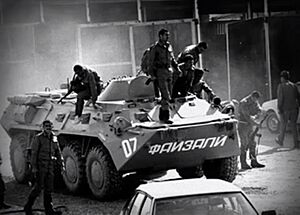
The war lasted until 1997. More than 500,000 people fled the country because of the fighting and poverty. Over 100,000 people died. About 1.2 million people became refugees inside or outside the country.
Emomali Rahmon became president in 1992. He won an election in November 1992. In 1997, a ceasefire (an agreement to stop fighting) was reached between Rahmon and the opposition groups. This was seen as a successful effort by the United Nations. The agreement gave the opposition 30% of government positions.
Rahmon was re-elected in 1999 and 2006. Some observers criticized these elections as unfair.
Russian border troops stayed along the Tajik–Afghan border until 2005. After the September 11, 2001 attacks, French troops were stationed at Dushanbe Airport to support NATO operations in Afghanistan. The United States Army and Marine Corps also visit Tajikistan for training missions.
In 2021, Tajikistan was reportedly involved in the Panjshir conflict against the Taliban in Afghanistan. In September 2022, there were armed clashes along the border between Kyrgyzstan and Tajikistan.
Tajikistan's Geography
Tajikistan is the smallest country in Central Asia by land area. It is mostly covered by the Pamir Mountains. Most of the country is over 3,000 meters (9,800 feet) above sea level. Lower lands are found in the north, in the Fergana Valley, and in the southern river valleys of the Kofarnihon and Vakhsh. Dushanbe is located on the southern slopes above the Kofarnihon valley.
| Mountain | Height | Location | ||
| Ismoil Somoni Peak (highest) | 7,495 m | 24,590 ft | North-western edge of Gorno-Badakhshan (GBAO), south of the Kyrgyz border | |
| Ibn Sina Peak (Lenin Peak) | 7,134 m | 23,537 ft | Northern border in the Trans-Alay Range, north-east of Ismoil Somoni Peak | |
| Peak Korzhenevskaya | 7,105 m | 23,310 ft | North of Ismoil Somoni Peak, on the south bank of Muksu River | |
| Independence Peak (Revolution Peak) | 6,974 m | 22,881 ft | Central Gorno-Badakhshan, south-east of Ismoil Somoni Peak | |
| Academy of Sciences Range | 6,785 m | 22,260 ft | North-western Gorno-Badakhshan, stretches in the north–south direction | |
| Karl Marx Peak | 6,726 m | 22,067 ft | GBAO, near the border to Afghanistan in the northern ridge of the Karakoram Range | |
| Garmo Peak | 6,595 m | 21,637 ft | Northwestern Gorno-Badakhshan. | |
| Mayakovskiy Peak | 6,096 m | 20,000 ft | Extreme south-west of GBAO, near the border to Afghanistan. | |
| Concord Peak | 5,469 m | 17,943 ft | Southern border in the northern ridge of the Karakoram Range | |
| Kyzylart Pass | 4,280 m | 14,042 ft | Northern border in the Trans-Alay Range | |
The Amu Darya and Panj rivers form the border with Afghanistan. Glaciers in Tajikistan's mountains feed the Aral Sea. There are over 900 rivers in Tajikistan that are longer than 10 kilometers.
Regions of Tajikistan
Tajikistan is divided into four main areas. These are the provinces of Sughd and Khatlon, the special region of Gorno-Badakhshan (GBAO), and the Regions of Republican Subordination. Each region is further divided into districts, which are then split into villages.
| Division | ISO 3166-2 | Map No | Capital | Area (km2) | Pop. (2019) |
|---|---|---|---|---|---|
| Sughd | TJ-SU | 1 | Khujand | 25,400 | 2,658,400 |
| Region of Republican Subordination | TJ-RR | 2 | Dushanbe | 28,600 | 2,122,000 |
| Khatlon | TJ-KT | 3 | Bokhtar | 24,800 | 3,274,900 |
| Gorno-Badakhshan | TJ-GB | 4 | Khorugh | 64,200 | 226,900 |
| Dushanbe | Dushanbe | 124.6 | 846,400 |
Tajikistan's Economy
In 2019, almost 29% of Tajikistan's economy came from money sent home by people working in other countries, mostly Russia. This means the economy can be affected by problems in other countries. After the civil war, international help was very important. This help supported programs to bring former soldiers back into civilian life.
In 2001, the Red Cross announced that Tajikistan was facing a famine and asked for international aid. In 2012, over 680,000 people in Tajikistan did not have enough food. The World Food Programme (WFP) predicts that 30% of the population will suffer from malnutrition in 2023.
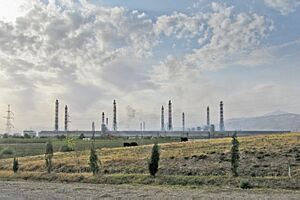
Tajikistan's economy grew after the civil war. From 2000 to 2007, its economy grew by an average of 9.6% each year. The main sources of income are aluminium production, cotton farming, and money from workers abroad. Cotton makes up 60% of farm products and supports 75% of people in rural areas. The state-owned Tajik Aluminum Company is the largest aluminium plant in Central Asia.
Tajikistan's rivers, like the Vakhsh and Panj, have great potential for making electricity from water (hydropower). The government wants to attract money to build more hydropower projects. These projects would provide electricity for Tajikistan and for export to other countries.
Tajikistan is home to the Nurek Dam, which is the second highest dam in the world. Another project, the Rogun power plant, is planned to be even taller. A project called CASA-1000 will send electricity from Tajikistan to Pakistan through Afghanistan. Tajikistan also has coal, natural gas, and oil reserves.
In 2014, Tajikistan was the most dependent country on money sent home by workers, with remittances making up 49% of its economy. This amount was expected to drop by 40% in 2015 due to economic problems in Russia. The World Bank warned that many Tajik men would return home and find few job opportunities.
Despite these challenges, Tajikistan has moved from a planned economy to a market economy. It has done this mainly by exporting its cheap labor. Money sent home by workers has helped reduce poverty and boost the economy. Besides Russia, China is also an important economic partner for Tajikistan.
Traveling in Tajikistan
Since Tajikistan is a landlocked country, it has no seaports. Most transportation happens by roads, air, and rail. Tajikistan has been working with Iran and Pakistan to get access to their ports through Afghanistan. In 2009, an agreement was made to build a 1,300 km highway and rail system connecting the three countries to Pakistan's ports.
Rail Travel
Tajikistan has about 680 kilometers (420 miles) of railway tracks. Most of these are in the southern part of the country. They connect the capital, Dushanbe, with industrial areas and with Uzbekistan, Turkmenistan, Kazakhstan, and Russia. Most international goods are transported by train.
Air Travel
In 2009, Tajikistan had 26 airports. 18 of these had paved runways. Two airports had runways longer than 3,000 meters (9,800 feet).
Roads and Bridges
The total length of roads in Tajikistan is 27,800 kilometers (17,270 miles). Cars and trucks carry most of the passengers and goods within the country.
In 2004, the Tajik–Afghan Friendship Bridge was built. This bridge connects Afghanistan and Tajikistan, improving Tajikistan's access to South Asia. The United States built this bridge.
Many highway and tunnel construction projects have been completed or are underway. These include improving roads connecting Dushanbe to the Uzbek and Chinese borders. Tunnels have also been built under mountain passes to make travel easier. These projects have received support from other countries.
People and Culture
| Year | Million |
|---|---|
| 1926 | 0.83 |
| 1950 | 1.5 |
| 2000 | 6.2 |
| 2018 | 9.1 |
In 2021, Tajikistan had about 9.7 million people. The Tajiks, who speak Tajik, are the largest ethnic group. There are smaller groups of Uzbeks and Russians. The number of Russians has decreased due to people moving away. This makes Tajikistan the only Central Asian country where Turkic people are a minority.
The Pamiris from Badakhshan and the Yaghnobi people are considered part of the larger Tajik group. People who live in Tajikistan are called Tajikistanis.
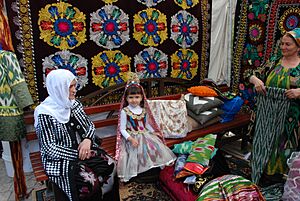
In 1989, Russians made up 7.6% of the population. By 1998, this number dropped to about 0.5% because many left during the civil war. The number of ethnic Germans has also almost disappeared since the Soviet Union broke up.
Most Tajiks live in Tajikistan, but many also live in northern and western Afghanistan. Tajiks are a minority in Uzbekistan. About 2.4 million Tajik citizens were officially registered in Russia in 2021.
Languages Spoken
The official languages of Tajikistan are Tajik and Russian. Tajik is the state language. Russian is used for communication between different ethnic groups.
Tajik is written using the Tajik Cyrillic alphabet. Millions of Tajik speakers live in neighboring Uzbekistan and Russia.
About 90% of people in Tajikistan speak Russian to some extent. The Russian spoken in Tajikistan is sometimes called Tajik(istani) Russian. It has some unique words and ways of speaking.
Some words are used by both Russian and Tajik speakers when talking to people they don't know well:
| Tajikistani Russian | Standard Russian | English translation |
|---|---|---|
| апа | старшая сестра | older sister |
| ака | старший брат | older brother |
| хола | тетя | aunt |
| янга | жена брата, невестка | daughter-in-law; sister-in-law |
Educated people in Tajikistan often prefer to speak Russian and Persian.
Native Uzbek speakers live in the north and west of Tajikistan. Pamir languages are spoken in the Kuhistani Badakshshan Autonomous Region. Most Zoroastrians in Tajikistan speak a Pamir language. Kyrgyz language speakers live in the north of this region. Yagnobi language speakers live in the west. The Parya language is spoken by local Romani people. Tajikistan also has communities that speak Persian, Arabic, Pashto, Armenian, Azerbaijani, Tatar, Turkmen, Kazakh, Chinese, and Ukrainian.
Religions in Tajikistan
| Religion in Tajikistan, 2020 | ||||
|---|---|---|---|---|
| Religion | Percent | |||
| Islam | 97.5% | |||
| Christianity | 0.7% | |||
| Unaffiliated | 1.7% | |||
| others | 0.2% | |||
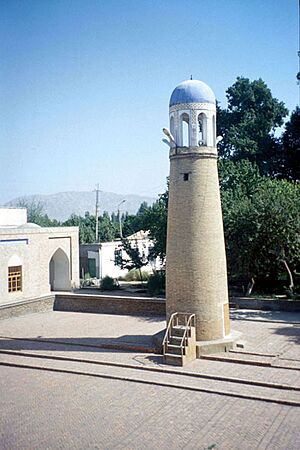
Tajikistan is a secular state, meaning the government is separate from religion. The constitution allows freedom of religion. However, the government does regulate the practices of its Muslim majority. Sunni Islam of the Hanafi school has been officially recognized since 2009.
About 1.6% of the population is Christian, mostly Orthodox Christians. There are also small communities of Catholics, Armenian Christians, Protestants, and other Christian groups.
Education System
Almost everyone in Tajikistan (99.8%) can read and write.
Public education includes 11 years of primary and secondary school. The government planned to change this to a 12-year system in 2016. There are several universities and colleges. These include Khujand State University and Tajik National University. Most universities were started during the Soviet era.
In 2008, only 17% of young people went to college. This was lower than the average for the region. Public spending on education was fairly steady between 2005 and 2012. However, the United Nations said that this spending was not enough for the country's education system.
A survey supported by UNICEF found that about 25% of girls in Tajikistan do not finish primary school. This is due to poverty and gender bias. Even so, reading and writing skills are generally high in Tajikistan.
In September 2017, the University of Central Asia opened a campus in Khorog, Tajikistan. It offers studies in Earth & Environmental Sciences and Economics. In 2024, Tajikistan was ranked 107th in the Global Innovation Index.
Science in Tajikistan had great achievements in the Middle Ages. Scientific organizations were created during the Soviet period. After independence, science faced some challenges. However, universities continue to contribute to scientific research.
Tajik Culture and Traditions
The Tajik language is the main language for about 80% of people in Tajikistan. Major cities include Dushanbe (the capital), Khujand, Kulob, and Panjakent. There are also Uzbek, Kyrgyz, and Russian minorities.
The Yaghnobi people live in northern Tajikistan. There are about 25,000 Yaghnobis. They speak the Yaghnobi language, which comes directly from the ancient Sogdian language.
Tajik artisans created the Dushanbe Tea House. This beautiful building was given as a gift to Boulder, Colorado, a sister city, in 1988.
Many women in Tajikistan still wear traditional national clothing. Seamstresses and embroiderers use factory fabrics and local needlework for home decorations and women's clothes. The art of Chakan embroidery is passed down from one generation of women to the next.
Popular Sports
The national sport of Tajikistan is gushtigiri, which is a type of wrestling.
Another popular sport is buzkashi. This is a game played on horseback, similar to polo. In buzkashi, players try to grab a 50 kg (110 lb) dead goat. They then ride away from other players and drop it in a special circle. Buzkashi is often played during Nowruz celebrations.
Tajikistan is a popular place for mountaineering.
The Tajikistan Cricket Federation was started in 2012 to manage the sport of cricket in Tajikistan. It became a member of the Asian Cricket Council in the same year.
In 2008, rugby union was officially recognized. There are three men's rugby clubs in the country.
Khorugh, the capital of Gorno-Badakhshan Autonomous Region, is known for being the highest place where bandy (a sport similar to ice hockey) has been played.
Tajikistan has one ski resort called Safed Dara. It is located near the town of Varzob.
See also
 In Spanish: Tayikistán para niños
In Spanish: Tayikistán para niños
- Armed Forces of the Republic of Tajikistan
- Central Asian Union
- Dushanbe
- Foreign relations of Tajikistan
- Gorno-Badakhshan Autonomous Province
- List of cities in Tajikistan
- Mass media in Tajikistan
- Russian Turkistan
- Tajikistani Civil War
- Yaghnob Valley




